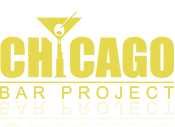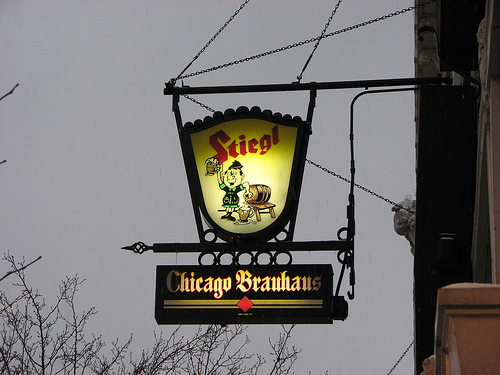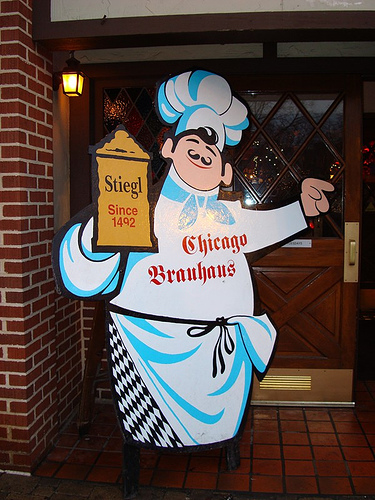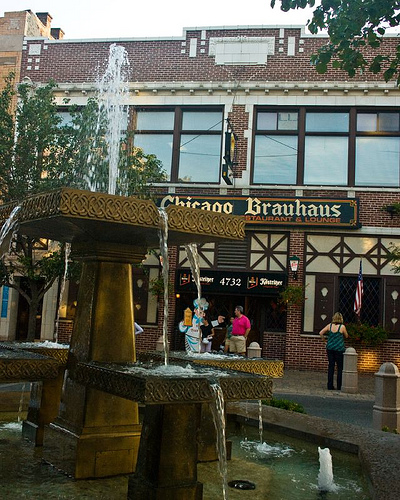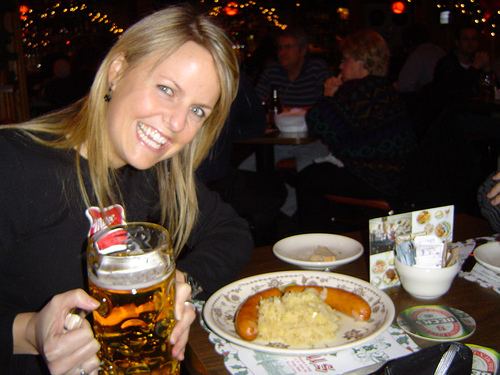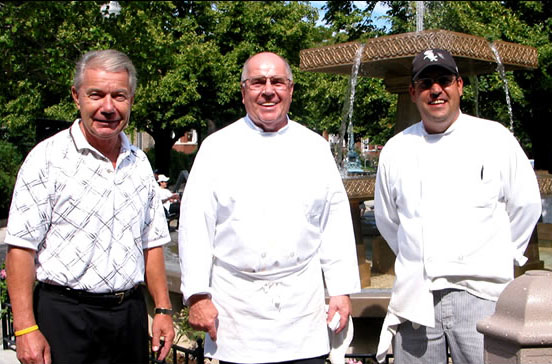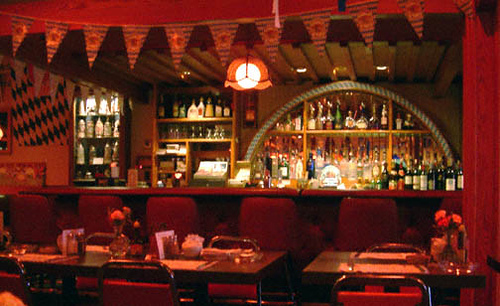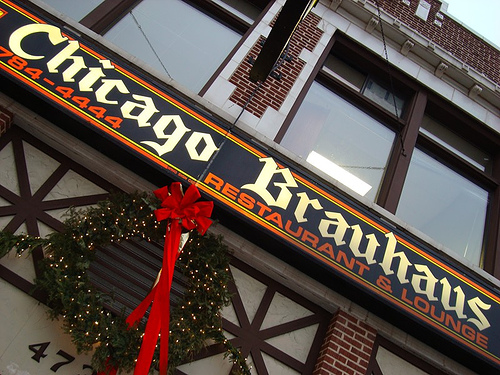“It is always Oktoberfest in the Brauhaus”
Editor’s Note: after 52 years in business, our beloved Brauhuas served its last glass boot on December 11, 2017. Fortunately, the Dank Huas has set up a memorial exhibition on its second floor that you can visit, with carpet from the actual Brauhaus. Auf wiedersehen, mein freund!
With its origins dating back to November 1965, the Chicago Brauhaus has been the epicenter of activity in Chicago’s Lincoln Square neighborhood, thanks to the founding brothers, Guenter and Harry Kempf. Biergartens originally flourished in this part of “Chicagoburg,” thanks to the Saloon Keeper’s Society, which was organized to “protect and demand their common interests by all lawful means and measures.” Since then, Lincoln Square has become more culturally diverse, having attracted Greek, Thai, Mexican, Korean, Serbian people, and now Irish thanks to The Grafton. However, the Brauhaus stands as a remaining bastion of Germanic beer hall heritage, especially with the demise of other North Side legends, Zum Deutschen Eck, Schwaben Stube and the Golden Ox.
Das Brauhaus is located along the Lincoln Avenue pedestrian mall. To find it, just look for the large, stately brick restaurant with its yellow lanterns and portly chef sign advertising Steigl beer across from the Lincoln Square fountain. As you walk in the Brauhaus through the wooden double doors, you’ll encounter an authentic Hofbrauhaus, meaning “beer house” in German (not to be confused with the infamous House of Beer located on Division Street). The atmosphere here ist sehr gemütlich, being filled with plenty of Germans, Bavarian-style long wooden tables, stained glass windows, banquet-style chairs, murals of the Reichland (as well as one depicting Chicago), and a plethora of German beer advertising and tiny German flags. Be sure not to dawdle as you take it all in as stout, gruff-mannered German waitresses in traditional dress that sing along with the band will not hesitate to yell out, “Move! Get out of the way!” as they whisk through the room carrying trays of heavy glass beer steins that a grown man would have difficulty with. Please take note: these waitresses are not to be trifled with: “You vill eat your potato salad und you vill like it!” They’re a little more warm if it’s your birthday as they’ll decorate your table with balloons, paper steins, and will prop embarrassing, blown-up childhood photographs of you in front of the band. Step up to the maitre’d stand on your right to get a table, or head into the bar area that runs along the north end of the room with its giant carved wood beer bottle and ceramic beer steins, some of which are for sale.
For entertainment, there is a one-man, electronic-accordion-band whom jams happily away in his lederhosen to Edelweiss and Roll out the Barrel in the afternoon on weekends. Lounge lizards will appreciate The Brauhaus Trio, who play every night except Tuesday. This traditional German band is fronted by a man named Gody who is referred to as the “Austrian Elvis” by the Chicago Brauhaus and “Austrian Larry Bird” by my friends, due to his likeness to the original Boston Celtic. The band compliments their inventive name with such oompah-fied hits as Una Paloma Blanca, Country Road, Achy Breaky Heart and Unchained Melody to swooning crowds of elderly Fraus. Marvelous. For further enjoyment, check out the antique musical
instruments on the wall, behind the stage. Additional entertainment can be found with the patrons, which are a combination of older Germans in their best loungewear and younger condo and apartment dwellers. The latter may at first be shocked by the spectacle of grayhairs but easily join in as resounding cheers of “Hey!” or “Prost!” routinely cascade through the bar as old and young alike clink their glasses with those at their table and anyone else in the room that eye contact is made with. These rounds of cheers are caused by anything from the bandleader making a toast, to a girl seen trying to steal a German flag, to the presence of a large man in traditional lederhosen, to someone getting up to go to the bathroom, or to the annual descending of “Robefest” onto the Brauhaus.
Robefest consists of up to 60 South-Siders on a Lincoln Square pub crawl, dressed only in robes. You’ve not lived until you’ve seen 60 rowdy people in robes fill up the Brauhaus clinking glasses incessantly with everyone in the room. No one is safe when Robefest comes to your bar, especially if “Creepy Bob” is part of it. On another night, Creepy Bob was once called upon to scare off a table full of girls so that a group of his friends could sit down. To do this, he walked up to the table and asked, “How are you ladies doing?” He did not get that friendly of a response so he unbuttoned his shirt and said, “How you doing now?” As the girls became increasingly uncomfortable, he added: “With this, you don’t need a puppy.” He then licked his finger, touched one of the girls on her shirt and said, “Why don’t you get out of those wet clothes?” The girls couldn’t leave the bar fast enough. They even left a half-full pitcher of beer. Creepy Bob and friends took the booth and downed the pitcher. Mission accomplished.
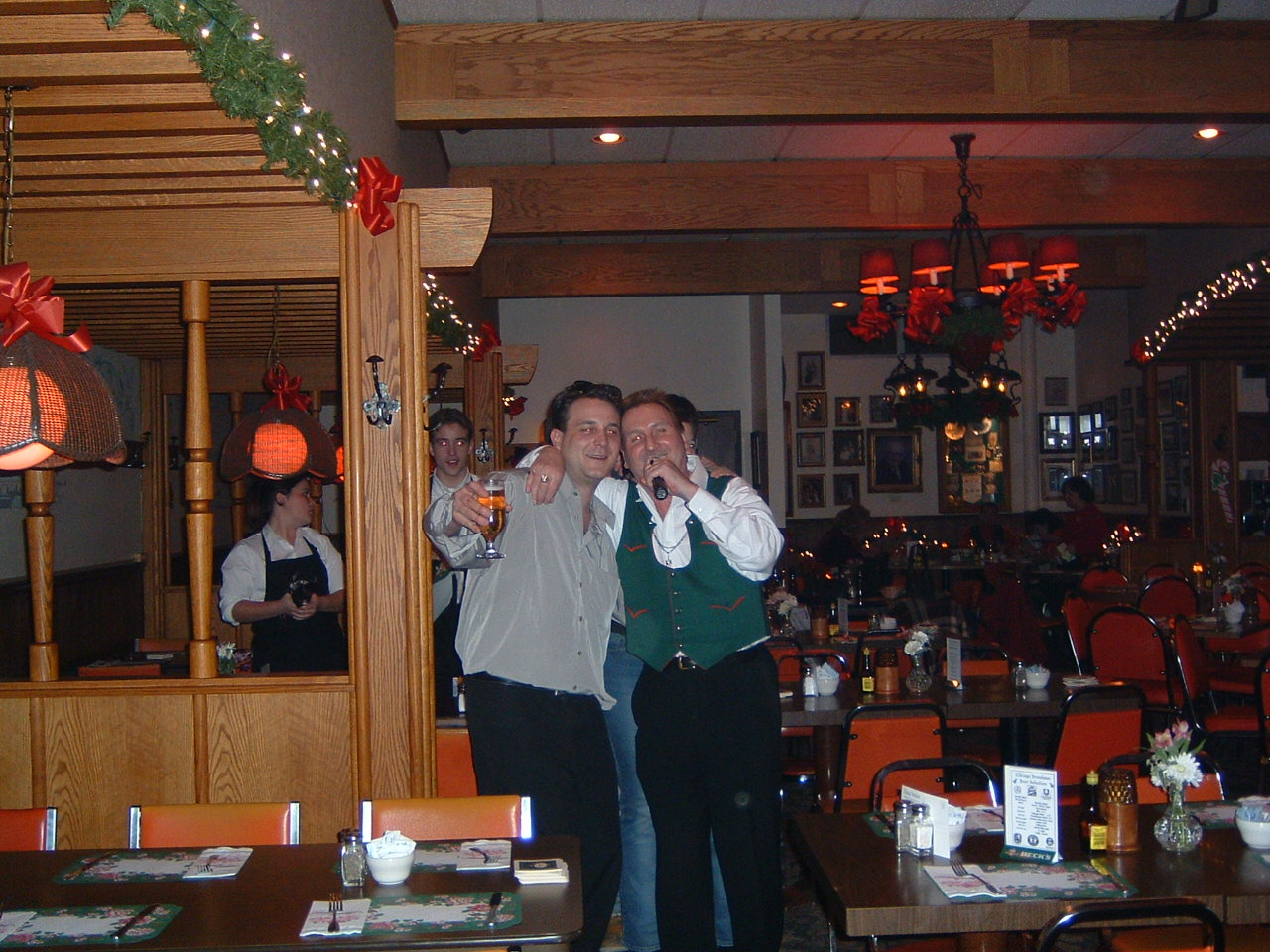
The one and only “Austrian Larry Bird” with inebriated patron
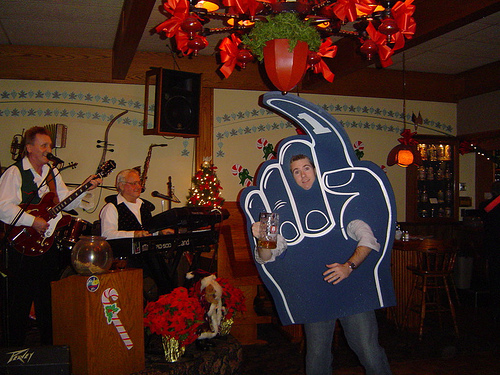 Photo courtesy of Art Sindlinger According to a friend: “Even a better story about Creepy Bob was when he had an Amish Beard back in college. At some party a girl asked if he was Amish, he responded by saying, ‘Yes, French Amish, we can drink and go to parties but just can’t turn on or off the lights.’ She was so amazed on how up to date on current events he was that he set up a date for a few days later. Then he picked her up in his car and it was not until then she realized he wasn’t Amish. I think he said the date lasted about an hour before she asked him to take her home and drop her off.”
Photo courtesy of Art Sindlinger According to a friend: “Even a better story about Creepy Bob was when he had an Amish Beard back in college. At some party a girl asked if he was Amish, he responded by saying, ‘Yes, French Amish, we can drink and go to parties but just can’t turn on or off the lights.’ She was so amazed on how up to date on current events he was that he set up a date for a few days later. Then he picked her up in his car and it was not until then she realized he wasn’t Amish. I think he said the date lasted about an hour before she asked him to take her home and drop her off.”
As you would expect, the Brauhaus has an impressive selection of German bier including Erdinger Weissbrau, Spaten, Warsteiner, Diebels, Hofbrau, Bitburger, Franziskaner Weiss, Becks, and Steigl (Austrian). I recommend the Spaten Optimator, which is an excellent dark beer from a brewery founded during the Middle Ages in 1397. American beer enthusiasts and people with bad taste will appreciate the availability of Rolling Rock, Schlitz, and more importantly, Stroh’s and Stroh’s Light (not to be found anywhere else in the city). All draft beer at the Brauhaus is served in glass steins, with a choice of one-liter and half-liter. The one-liter glass steins are nothing short of enormous. If you order one, take note that the bathrooms are located in the basement, accessible from a carpeted staircase that can be found in the southeast corner of the bar. There is also what looks like a quarter-liter stein for the ladies, although any German Frau worth her salt would be able to pound a liter with the best of ’em. Ever wonder why the glass steins are so thick? It’s because Germans tend to slam their glasses together, rather than a gimpy clink like everyone else is used to. Because of this, the proper way to hold a stein is to wrap your fingers through the handle and around the stein rather than just holding the stein from the handle. This will help prevent the bloodying of your knuckles during the next wave of “Prost!”
 The atmosphere at the Brauhaus is particularly festive during Lincoln Square’s Octoberfest, held during the second weekend in September. As any German knows, the original “Oktoberfest” is held in Munich, the capital of Germany’s free state of Bavaria, stems from the celebrations around the marriage of Crown Prince Ludwig (Ludwig I) of Bavaria to Princess Therese of Saxon-Hildburghausen on October 12, 1810. The festivities concluded with a horse race held on the “Theresienwiese” or “Field of Theresa,” in honor of the bride. The festival was a hit in Bavaria, giving birth to “The Wiesn,” as it is still called by Bavarians. We all know “The Wiesn” as “Oktoberfest” because that is the month in which it originally started and now ends. However, because the weather can still be quite warm towards the end of September, savvy festival promoters and local breweries moved up the starting date to 16 days before the first Sunday in October. Though it has been cancelled two dozen times because of a few wars (Napleonic, Austro-Prussion, Franco Prussian, World War I and II), as well as a cholera epidemic in the mid-1800s, post-WWI inflation, and post-WWII rebuilding, Oktoberfest has been going strong since 1810.
The atmosphere at the Brauhaus is particularly festive during Lincoln Square’s Octoberfest, held during the second weekend in September. As any German knows, the original “Oktoberfest” is held in Munich, the capital of Germany’s free state of Bavaria, stems from the celebrations around the marriage of Crown Prince Ludwig (Ludwig I) of Bavaria to Princess Therese of Saxon-Hildburghausen on October 12, 1810. The festivities concluded with a horse race held on the “Theresienwiese” or “Field of Theresa,” in honor of the bride. The festival was a hit in Bavaria, giving birth to “The Wiesn,” as it is still called by Bavarians. We all know “The Wiesn” as “Oktoberfest” because that is the month in which it originally started and now ends. However, because the weather can still be quite warm towards the end of September, savvy festival promoters and local breweries moved up the starting date to 16 days before the first Sunday in October. Though it has been cancelled two dozen times because of a few wars (Napleonic, Austro-Prussion, Franco Prussian, World War I and II), as well as a cholera epidemic in the mid-1800s, post-WWI inflation, and post-WWII rebuilding, Oktoberfest has been going strong since 1810.
At Lincoln Square’s Octoberfest, just about anything you can find at the real Oktoberfest in Munich can be found here in Chicago: huge beer tents, plenty of beer and sausage, and oompah bands. Just make sure you get your tickets early as four booths, each with two little old ladies, dispense tickets at a snail’s pace resulting in lines with half-hour waits. If you encounter this before you’ve had a chance to get your tickets, just head over to the Huettenbar, across from the Brauhaus, where all draft beer is served in plastic cups so that you can drink them out on the street and Jägermeister shots are sold just outside the bar. Back at the Brauhaus, co-owner Guenter Kempf says he goes through about 150 kegs of Oktoberfest Spaten beer during Lincoln Square’s Octoberfest and the three weeks that follow. The Brauhaus also features yodeling and dancing contests, and hats with a feather on sale for $1.50 (what a bargain).
The food is spanking gorgeous as well, with such German classics as sauerbraten, weinerschnitzel, rouladen (slices of beef rolled around a pickle, onion and bacon mixture), liver dumpling soup, red cabbage, creamed herring, veal shank, Kassler rippchen (smoked pork), roasted goose and rabbit, and apple strudel – all of which is made from scratch. Try not to fill up on the excellent bread and cabbage soup that comes prior to your meal. This orgy of food is even served on dishes from the Old Country. Expect to pay about $25, which is entirely worth it.
“Every night is more fun than a pair of Lederhosen made for two”
– Shecky’s Bar, Club & Lounge Guide 2002
According to the June 2005 Lincoln Square Chamber of Commerce article, “It all began in 1963 at the corner of Wilson and Lincoln. The place had a long tradition as a tavern, as A.C. Kummer’s and Hogen’s (now the site of the Daily Bar and Grill). Harry [Kempf – founder] had arrived in the U.S. at 19 and went to Western Electric as a tool and die worker. At night, he played and sang with a big band in clubs and dance halls around the city. He did well at his job, but didn’t feel like he was pursuing his dreams. So he decided to go into business with a partner and opened Zum Lieben Augustin at 4560 North Lincoln. At that time, there were a lot of German, Swiss and Austrian immigrants in the area,’ says Harry. ‘No one offered live music every day like we did. The first day we opened, there was a line half a mile down the street to get in.’ His partner handled the food and Harry handled the entertainment. It was an instant success. But soon, Harry was anxious to have his own place.
“Meanwhile, Guenter came to the U.S. in 1965. He immediately planned to open a new restaurant with his brother Harry, called Treffpunkt, which translates to ‘meeting place’ in German. After word began to spread, Treffpunkt started drawing crowds of people who came for the food and entertainment to its location at the corner of Lincoln and Giddings, across the street from the building where Café Selmarie is now. Treffpunkt built up a reputation for good food and music and even received a visit from then-president Ronald Reagan. In 1979, when Lincoln Avenue was being rebuilt and traffic re-routed onto Leland, Harry and Guenter decided that they needed to do something to bring in business to the area. So they decided to hold the first Oktoberfest in Lincoln Square. They set up a big tent down Lincoln that ran from Lawrence Avenue all the way to the Huettenbar. They brought in bands, beer and grilled up brats. ‘We cooked 10,000 brats in two days,’ says Harry. ‘That was the start of the German Fest.’
“Treffpunkt’s success inspired Harry and Guenter to think about their next steps. ‘Across the street from us was Roehrich’s Furniture,’ Harry recalls. ‘We always said to him, ‘Whenever you retire, please give us a shot at buying this place.’ So eventually we bought it and fixed it up so that we could use it to do some additional catering. It was like a warehouse, so we started by installing a kitchen where we could work.’ Then, in 1984, the entire block where the Treffpunkt was located burned down. Harry and Guenter knew that they needed to rebuild the business. Luckily, they could start again using the Roehrich’s Furniture building [formerly a bowling alley] across the street, which already had an operating kitchen. That was the birth of the Chicago Brauhaus. ‘We decided to get away from a German name,’ says Harry. ‘We saw a need for a house for everybody, where you could go with the flow and the surroundings were comfortable. We wanted people to feel content and want to stay a while after eating to have a drink.’ They felt that Chicago Brauhaus would be the best name for this type of place.”
Founders and son
Today, the Chicago Brauhaus appeals to new and old neighborhood denizens alike, as well as the occasional visit from Mayor Daley and schoolchildren throughout the Chicagoland area who are learning German. My recommendation: take in the Brauhaus on a lazy Sunday afternoon or Friday night. If you are with a large party, ask for the circular table at the back, which is surrounded by German paraphernalia including more beer steins and photographs of rotund German men in their requisite lederhosen attire. If the Brauhaus is not enough Germania for you, stop by the headquarters of Amerika Woche, a newspaper for Germans living in the US, located on the second floor. Afterwards, stop by the Merz Apothecary for a holistic remedy, Timeless Toys for a wooden toy, Cafe Lutz’s “konditorei” to satisfy your sweet tooth, or one of the German delis for a knackwurst to take home.
Overall, the Brauhaus is a great slice of old world Deutschland here in Chicago and is the type of place that a man might toss you his hat and ask you to hang it up for him on the coat rack, and where people still drink beer at lunchtime. If you like the Brauhaus, you may also want to visit Resi’s Bierstube or Laschet’s Inn located further south on Irving Park Road, or Mirabell on Addison just east of the Kennedy for additional Gemütlichkeit. For more information, including special events, check out the Chicago Brauhaus website. Ja wohl, Ich bin einen Deutscher!
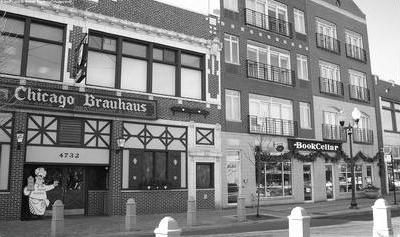
Photo courtesy of Carla G. Surratt of Picturing Chicago
